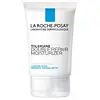What's inside
What's inside
 Key Ingredients
Key Ingredients

 Benefits
Benefits

 Concerns
Concerns

 Ingredients Side-by-side
Ingredients Side-by-side

Water
Skin ConditioningGlycerin
HumectantSqualane
EmollientDimethicone
EmollientZea Mays Starch
AbsorbentNiacinamide
SmoothingAmmonium Polyacryloyldimethyl Taurate
Emulsion StabilisingMyristyl Myristate
EmollientStearic Acid
CleansingCeramide NP
Skin ConditioningPotassium Cetyl Phosphate
EmulsifyingGlyceryl Stearate Se
EmulsifyingSodium Hydroxide
BufferingMyristic Acid
CleansingPalmitic Acid
EmollientCapryloyl Glycine
CleansingCaprylyl Glycol
EmollientXanthan Gum
EmulsifyingWater, Glycerin, Squalane, Dimethicone, Zea Mays Starch, Niacinamide, Ammonium Polyacryloyldimethyl Taurate, Myristyl Myristate, Stearic Acid, Ceramide NP, Potassium Cetyl Phosphate, Glyceryl Stearate Se, Sodium Hydroxide, Myristic Acid, Palmitic Acid, Capryloyl Glycine, Caprylyl Glycol, Xanthan Gum
Water
Skin ConditioningGlycerin
HumectantCaprylic/Capric Triglyceride
MaskingOlea Europaea Fruit Oil
MaskingCetearyl Alcohol
EmollientButylene Glycol
HumectantButyrospermum Parkii Butter
Skin ConditioningPPG-3 Benzyl Ether Myristate
EmollientDi-C12-15 Alkyl Fumarate
EmollientDimethicone
EmollientGlyceryl Stearate
EmollientPEG-100 Stearate
Citrus Aurantium Dulcis Peel Oil
MaskingErythritol
HumectantPolysorbate 20
EmulsifyingAcrylates/C10-30 Alkyl Acrylate Crosspolymer
Emulsion StabilisingTetrahexyldecyl Ascorbate
AntioxidantCarbomer
Emulsion StabilisingEugenia Caryophyllus Leaf Oil
MaskingEthylhexylglycerin
Skin ConditioningTocopheryl Acetate
AntioxidantRetinyl Palmitate
Skin ConditioningSodium Ascorbyl Phosphate
AntioxidantMannitol
HumectantSodium Hyaluronate
HumectantSodium Lactate
BufferingCeramide Ns
Skin ConditioningAscorbic Acid
AntioxidantHomarine Hcl
Skin ConditioningTocopherol
AntioxidantBiotin
AntiseborrhoeicPentaerythrityl Tetra-Di-T-Butyl Hydroxyhydrocinnamate
AntioxidantSaccharomyces Cerevisiae Extract
Skin ConditioningVitis Vinifera Seed Extract
AntimicrobialPalmitoyl Tripeptide-1
Skin ConditioningPalmitoyl Tetrapeptide-7
Skin ConditioningPhenoxyethanol
PreservativePotassium Sorbate
PreservativeSodium Benzoate
MaskingSodium Hydroxide
BufferingLimonene
PerfumingEugenol
PerfumingLinalool
PerfumingIsoeugenol
PerfumingWater, Glycerin, Caprylic/Capric Triglyceride, Olea Europaea Fruit Oil, Cetearyl Alcohol, Butylene Glycol, Butyrospermum Parkii Butter, PPG-3 Benzyl Ether Myristate, Di-C12-15 Alkyl Fumarate, Dimethicone, Glyceryl Stearate, PEG-100 Stearate, Citrus Aurantium Dulcis Peel Oil, Erythritol, Polysorbate 20, Acrylates/C10-30 Alkyl Acrylate Crosspolymer, Tetrahexyldecyl Ascorbate, Carbomer, Eugenia Caryophyllus Leaf Oil, Ethylhexylglycerin, Tocopheryl Acetate, Retinyl Palmitate, Sodium Ascorbyl Phosphate, Mannitol, Sodium Hyaluronate, Sodium Lactate, Ceramide Ns, Ascorbic Acid, Homarine Hcl, Tocopherol, Biotin, Pentaerythrityl Tetra-Di-T-Butyl Hydroxyhydrocinnamate, Saccharomyces Cerevisiae Extract, Vitis Vinifera Seed Extract, Palmitoyl Tripeptide-1, Palmitoyl Tetrapeptide-7, Phenoxyethanol, Potassium Sorbate, Sodium Benzoate, Sodium Hydroxide, Limonene, Eugenol, Linalool, Isoeugenol
 Reviews
Reviews

Ingredients Explained
These ingredients are found in both products.
Ingredients higher up in an ingredient list are typically present in a larger amount.
Dimethicone is a type of synthetic silicone created from natural materials such as quartz.
What it does:
Dimethicone comes in different viscosities:
Depending on the viscosity, dimethicone has different properties.
Ingredients lists don't always show which type is used, so we recommend reaching out to the brand if you have questions about the viscosity.
This ingredient is unlikely to cause irritation because it does not get absorbed into skin. However, people with silicone allergies should be careful about using this ingredient.
Note: Dimethicone may contribute to pilling. This is because it is not oil or water soluble, so pilling may occur when layered with products. When mixed with heavy oils in a formula, the outcome is also quite greasy.
Learn more about DimethiconeGlycerin is already naturally found in your skin. It helps moisturize and protect your skin.
A study from 2016 found glycerin to be more effective as a humectant than AHAs and hyaluronic acid.
As a humectant, it helps the skin stay hydrated by pulling moisture to your skin. The low molecular weight of glycerin allows it to pull moisture into the deeper layers of your skin.
Hydrated skin improves your skin barrier; Your skin barrier helps protect against irritants and bacteria.
Glycerin has also been found to have antimicrobial and antiviral properties. Due to these properties, glycerin is often used in wound and burn treatments.
In cosmetics, glycerin is usually derived from plants such as soybean or palm. However, it can also be sourced from animals, such as tallow or animal fat.
This ingredient is organic, colorless, odorless, and non-toxic.
Glycerin is the name for this ingredient in American English. British English uses Glycerol/Glycerine.
Learn more about GlycerinSodium Hydroxide is also known as lye or caustic soda. It is used to adjust the pH of products; many ingredients require a specific pH to be effective.
In small amounts, sodium hydroxide is considered safe to use. However, large amounts may cause chemical burns due to its high alkaline.
Your skin has a natural pH and acid mantle. This acid mantle helps prevent harmful bacteria from breaking through. The acid mantle also helps keep your skin hydrated.
"Alkaline" refers to a high pH level. A low pH level would be considered acidic.
Learn more about Sodium HydroxideWater. It's the most common cosmetic ingredient of all. You'll usually see it at the top of ingredient lists, meaning that it makes up the largest part of the product.
So why is it so popular? Water most often acts as a solvent - this means that it helps dissolve other ingredients into the formulation.
You'll also recognize water as that liquid we all need to stay alive. If you see this, drink a glass of water. Stay hydrated!
Learn more about Water